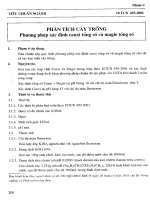Chapter 3: Preparation & Planning pot
Bạn đang xem bản rút gọn của tài liệu. Xem và tải ngay bản đầy đủ của tài liệu tại đây (181.72 KB, 27 trang )
Chapter 3
Preparation & Planning
Outline
Importance of Planning
Information Needs
Negotiation Game Plan
Intelligence Gathering
Choice Point Contrivance & Response
Negotiating Styles
Why Plan?
Critical to successful negotiations
Provides the ability to set the tone and
direction of the negotiation
Individuals with higher levels of planning
inclinations will have more successful
negotiation outcomes than those who are
less preparation-inclined.
Information Needs
Negotiators should know:
•
Other parties’ needs & interests
•
Available resources of the other party
•
Reputation and styles of the other parties
•
Ability and authority of other party to make
agreements
•
Strategies & tactics the other party might utilize
•
Understanding of when the other party might
walk away from the negotiations
Negotiation Game Plan
Important to be prepared for any situation –
competitive or cooperative
Organize
Thoughts
Identify Ideal
Outcomes
Develop
Contingencies & BATNA
Steps to Prepare for Negotiation
Negotiation Game Plan continued
Identify communication elements
•
Tone for negotiation (e.g. apologetic,
determined, concerned)
•
Frames for describing positions (e.g. metaphors,
analogies)
•
Body language to maximize effectiveness
•
Claims, data, objective criteria
•
Questions
•
Persuasion strategies
•
Methods to ensure commitments
Intelligence Gathering
Skilled negotiator gathers intelligence:
•
Interests – mutual & divergent
•
Concerns – mutual & divergent
•
Emotional issues
•
Primary claims
•
Evidentiary support – strengths & weaknesses
•
Potential avenues around resistance
•
Style compatibility considerations
ICE Model: Three Key Perspective-
Shaping Factors
Before beginning any negotiation, the three
key perspective-shaping factors (interests,
concerns & emotions) must be assessed – not
assumed!
Concerns
Interests
Emotions
Identifying Interests
Skilled negotiators must elicit information regarding
the others’ interests – both mutual and divergent
Utilize self-disclosure to encourage openness
Share a story of a previous negotiation
Place interests in continuum from mutual-to-
divergent
•
When interests are mutual, cooperative or integrative
negotiation is likely
•
When interests are divergent, antagonistic, distributive
forms of negotiation emerge
Identifying Concerns
All parties have concerns or worries
Failure to address or identify concerns may
hinder successful negotiations
Identifying Emotions
Individuals may become emotionally involved
with issues or positions
Emotions may be as important as rational or
cognitive arguments
If emotions are ignored, negotiations may
fail
Identifying Primary Claims
Defined: Statements about interests that each
negotiator is likely to make
Argument development
•
Claim – outcome or position for which you’re arguing
•
Data – evidence or reasoning supporting the claim
•
Warrant – general statement that indicates why the data
are supportive of the claim
Dissect reasoning to identify potential weaknesses
and develop stronger arguments
Lead with the strongest claims and ones that the
other party may care about or are likely to believe
Argument – Claim Development
Toulmin’s Model
Issue: ___________
Therefore
Data:
Claim:
Backing:
Because
Since
Warrant:
Using a Logical Vocabulary
Proposition – True or false statement within an
argument but not alone
Premise – Proposition used as evidence in an
argument
Conclusion – Proposition used as a thesis in an
argument
Argument – A group of propositions from which one
follows from another
Induction – Process through which premises provide
some basis for the conclusion
Deduction – Process through which premises provide
conclusive proof for the conclusion
Listen for Indicators
Argument indicators: should, must, ought,
necessarily
Premise indicators: since, because, for, as,
in as much as, for the reason that, first
Conclusion indicators: therefore, hence,
thus, so, consequently, it follows that, one
may infer, one may conclude
Prepare & Anticipate Counterclaims
Anticipate the possible ways in which your
counterpart might respond
Seek to understand
•
Acknowledge counterclaim
•
Assess counterclaim to gain better understanding
of their position
•
Respond – utilize other forms of substantive
evidence or data
•
Confirm agreement that you’ve addressed their
counterclaim
Identify Fallacies
Fallacies of relevance – occur when premises
are irrelevant to the conclusion
Fallacies of ambiguity – occur when
ambiguous, changeable wording in
propositions lead to more than one meaning
in an argument
Utilize Mind Maps
Brainstorm possible outcomes – areas of
disagreement
Think beyond simplistic outcomes
Visualize and rehearse the many possible
outcomes at various negotiation choice
points
Contriving Choice Points
Skilled negotiators plan ways to increase the
likelihood of obtaining the desired outcomes
Manage assumptions
Utilize persuasive communication to steer
dialogue to achieve objectives
Negotiating Styles
Every individual will have a negotiating or
communication style
•
Identify and understand your primary style
•
Identify the style of your counterpart
•
Utilize style flexing or stretching to be more
similar to your counterpart
Negotiations will be more successful when
styles match rather than conflict
What’s Your Style?
MEDIATOR
MOTIVATOR
ANALYZER
ACHIEVER
Employ hard tactics
Employ soft tactics
Mediator
Focuses on rapport
Favors consensus
Listens intently
Seeks mutual gain
More likely to utilize soft tactics
Motivator
Focuses on creativity
Uses analogies
Fosters collaboration
Encourages imagination
More likely to utilize soft tactics
Analyzer
Focuses on logic
Makes rational arguments
Relies on data
Prioritizes outcomes
More likely to utilize hard tactics
Achiever
Focuses on outcomes
Desires control
Adheres to plans
Seeks compliance
More likely to utilize hard tactics









